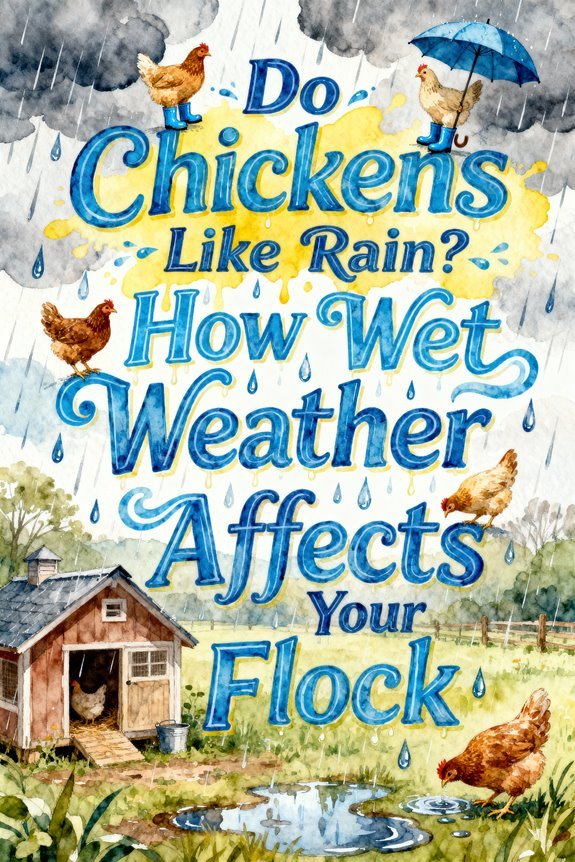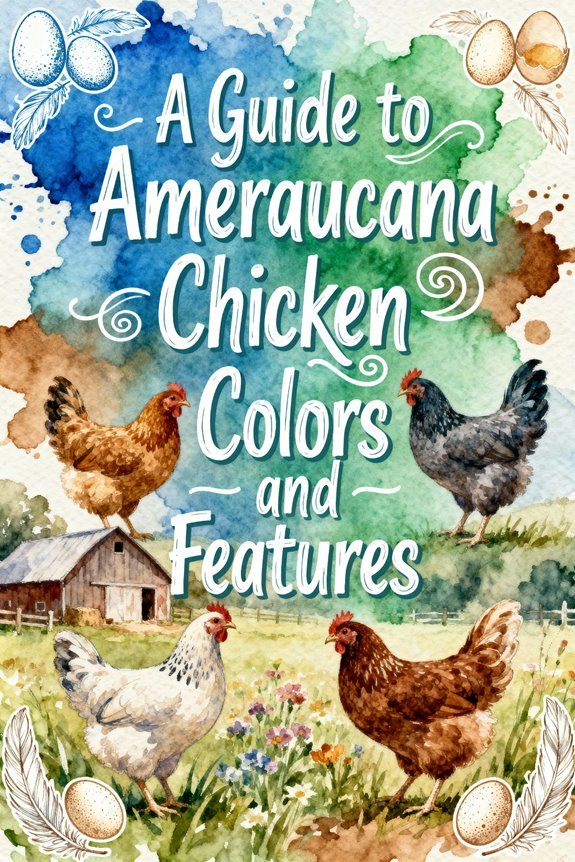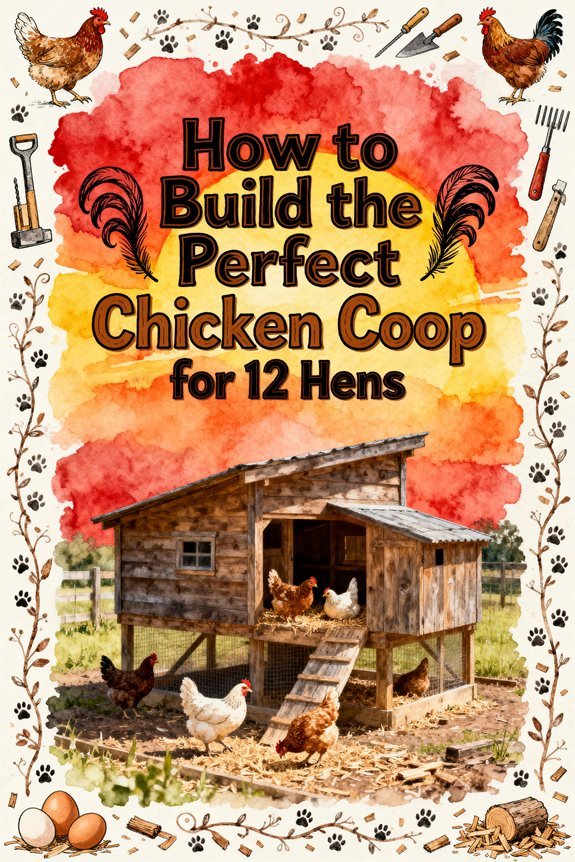Do Chickens Like Rain? How Wet Weather Affects Your Flock
Most chickens will actively avoid rain, seeking shelter when precipitation begins. While their water-resistant contour feathers offer protection from light rain, prolonged exposure to wet conditions can compromise their immune systems and increase risks of respiratory infections, parasites, and foot problems. You’ll need to provide adequate shelter, proper drainage, and elevated feeding stations to maintain your flock’s health during wet weather. Understanding your chickens’ specific needs during rainy conditions will help you implement the right protective measures.
Natural Chicken Behavior During Rainfall
While chickens possess water-resistant contour feathers that offer protection during light rainfall, their natural response to precipitation varies based on intensity and individual characteristics. Warmer summer temperatures make them more tolerant of rain exposure during outdoor activities. You’ll observe most adult birds engaging in shelter seeking behavior when rain becomes heavy, instinctively moving under coops, bushes, or other available cover.
Your flock’s behavioral adaptations during rainfall include reduced ranging and dust bathing activities, particularly when atmospheric pressure drops. While some breeds, like Sassos, demonstrate better tolerance to wet conditions, others, such as Silkies, need more protection due to their unique feather structure. You’ll notice your chickens clustering together for warmth and displaying cautious, yet not fearful, reactions to rain. They’ll often return outdoors once the rainfall subsides, especially if they’re experienced birds who’ve learned to gauge weather conditions.
Health Risks of Wet Weather for Your Flock
Although chickens can tolerate brief exposure to rain, prolonged contact with wet conditions poses considerable health risks to your flock. Persistent moisture compromises their immune systems, leading to respiratory infections from mold spores and ammonia buildup in damp coops. Wet environments create ideal breeding grounds for parasite infestations, including lice and mites, while reducing your chickens’ ability to control parasites through dust bathing. Maintaining good coop ventilation helps prevent harmful moisture accumulation that can compromise your flock’s respiratory health. Northern fowl mites can multiply rapidly in damp conditions, feeding on your chickens’ blood and causing severe stress and anemia.
Your flock’s foot health deteriorates in muddy conditions, potentially developing bumblefoot and other bacterial infections. Wet weather also increases exposure to harmful bacteria and molds in feed, water, and bedding. Watch for signs of hypothermia risks, particularly when feathers become soaked and lose their insulating properties. Your chickens may experience shivering, pale combs, and lethargy if their body temperature drops considerably. Pay special attention to your hens’ saddle feathers as they provide crucial insulation and protection during wet weather.
Protecting Your Chickens From Rain and Moisture
Since proper rain protection directly impacts your chickens’ health and comfort, implementing effective shelter solutions becomes essential for flock management. When selecting roofing options, consider polycarbonate storm panels or corrugated metal sheets for durable, long-term protection. These materials effectively seal your coop against precipitation while maintaining adequate ventilation. Consider installing hardware cloth underneath solid roofing materials for an extra layer of predator protection. A secure coop design helps prevent stress and promotes better egg production in your flock.
For moisture management, apply Pond Shield epoxy coating to interior surfaces, mixing construction sand into the final coat for slip resistance. You’ll need to guarantee proper drainage around the coop and run by filling low spots with materials like hay or sand. While pine shavings are commonly used, they contain harmful toxins that can affect respiratory health. Install adjustable vents above protective coverings to balance airflow with rain protection. During seasonal changes, you can employ removable tarps or portable shelters for additional flexibility in managing wet weather conditions.
Impact of Rain on Egg Production
Rainy weather greatly impacts egg production through multiple mechanisms that affect both laying frequency and egg quality. Your hens’ egg output typically decreases during wet periods due to increased disease susceptibility, reduced feed intake, and environmental stress factors.
You’ll notice rainfall effects are particularly pronounced when combined with temperature extremes above 80°F or during cold spells. High humidity and persistent rain create conditions that promote respiratory infections and coccidiosis, leading to reduced laying rates. The wet weather also affects your flock’s nutrition, as rain can contaminate feed and alter consumption patterns. Production can drop by 15 to 40 percent when hens experience weather-related stress. Healthy hens normally lay at one egg daily intervals of 24-26 hours, making weather disruptions particularly impactful on their natural cycle.
During rainy seasons, you’ll need to monitor your hens closely as their egg production efficiency decreases due to metabolic stress, compromised shell quality, and smaller egg sizes. These effects are compounded by reduced daylight hours and limited outdoor activity during wet weather. Even hardy breeds like Rhode Island Reds, known for producing 200-300 eggs annually, can experience decreased laying during prolonged wet conditions.
Managing Your Coop in Wet Conditions
When managing your coop during wet weather, proper design and maintenance become critical factors in protecting your flock’s health and comfort. Proper coop elevation on well-drained ground prevents flooding and waterlogging, while installing gutters and downspouts directs rainwater away from the foundation. You’ll need efficient drainage solutions, including french drains and porous ground materials like gravel or sand in high-traffic areas. Chickens that experience prolonged wet conditions often develop respiratory issues and reduced egg production. Maintaining a consistent supply of layer feed helps birds stay healthy and productive even during challenging weather.
Ensure your coop has a sloped, waterproof roof and adequate ventilation with protected openings to maintain airflow while keeping rain out. Use quality bedding materials like pine shavings or straw, implementing the deep litter method to manage moisture. Monitor humidity levels regularly and replace wet bedding promptly. Consider offering cracked corn before bedtime to help chickens generate extra body heat during cold, wet weather. For persistent wet conditions, consider raising your coop on stilts and rotating chicken runs to prevent sustained muddy conditions.
Signs of Weather-Related Stress in Chickens
Understanding weather-related stress in chickens requires careful observation of key behavioral and physical indicators. For effective stress management, you’ll need to recognize signs across various weather conditions. During hot weather, watch for panting and wing-spreading, while cold conditions trigger fluffed feathers and increased feed consumption. In wet weather, you’ll notice your chickens seeking shelter and showing reduced outdoor activity.
Signs identification becomes essential as weather stress can manifest through changes in your flock’s comb color, egg production, and overall energy levels. You’ll also observe variations in their eating patterns and social behaviors. Poor ventilation can create trapped heat microclimate conditions that worsen weather-related stress. Your chickens may display increased agitation during storms, heightened vigilance, and altered dust-bathing habits. These indicators help you assess their comfort level and implement appropriate protective measures.
Creating Weather-Safe Spaces for Your Birds
Creating weather-safe spaces for your chickens requires a thorough approach to structural protection and environmental control. Your coop design should incorporate high-quality polycarbonate storm panels (2.8mm thick) for impact resistance, while guaranteeing proper space allocation within sheltered areas. Install waterproof roofing and elevate the structure to prevent water infiltration. For optimal winter protection, transparent panels allow chickens to maintain visibility while staying protected from harsh elements. While chickens can tolerate subzero temperatures, proper shelter is essential for their survival.
You’ll need to implement heavy-duty run covers with secure bungee attachments, creating windbreaks that protect against driving precipitation while maintaining essential ventilation. Position the coop to face away from northwest winds for maximum cold weather protection. These protective elements should feature removable components for seasonal adaptation. Proper airflow is critical – incorporate passive updraft ventilation in roost areas to prevent respiratory issues and frostbite during cold weather. Regular inspection of weather protection installations guarantees long-term effectiveness, particularly before severe weather seasons.
Feeding Strategies During Rainy Weather
Proper feed management becomes critical during rainy conditions, as moisture poses significant risks to both feed quality and chicken health. You’ll need to store feed in waterproof containers and use covered feeders to prevent water contamination. Maintaining strict feeding hygiene includes regularly checking for mold, elevating feeders above wet ground, and promptly removing spoiled portions. Positioning waterers and feeders under protective awnings helps ensure your flock’s food stays clean and dry throughout wet weather. Just as chickens require proper feed management to avoid harmful bacteria, they should be prevented from consuming dog feces which can transmit diseases. Consider adding oregano oil supplements to feed during wet seasons to boost immune function and naturally fight bacterial growth.
Make nutritional adjustments during wet weather, as chickens expend more energy to stay warm. You’ll want to provide higher-energy feed formulations and monitor consumption patterns closely. Consider supplementing with energy-rich additives to meet their increased metabolic demands. Keep feeding areas dry by using proper drainage and bedding materials, and implement routine cleaning protocols for feeders and waterers to prevent bacterial growth and disease transmission.
Essential Supplies for Wet Weather Care
When managing chickens during wet weather, you’ll need an extensive set of supplies to maintain their health and comfort. Essential care items should include weatherproof tarps, shower curtains, and run covers with gutter edges to protect against rain while preserving light and ventilation. Your necessary equipment must feature heated water bases, multiple drinkers, and proper drainage systems. A heated drinker base is crucial for preventing water from freezing during cold, wet conditions. Installing nipple drinkers can help keep water sources clean and prevent contamination during rainy periods.
Keep a well-stocked first aid kit containing gauze, bandages, styptic powder, and wound treatments for weather-related injuries. You’ll need absorbent bedding materials like hemp or pine shavings, plus sand and gravel for run maintenance. Installing secure hardware cloth at ground level helps prevent predators from accessing your flock during vulnerable wet conditions. Include disinfectants and cleaning supplies to combat bacteria growth in damp conditions. Store extra tarps, bungee cords, and weatherproofing materials for quick repairs and modifications during extended wet periods.




